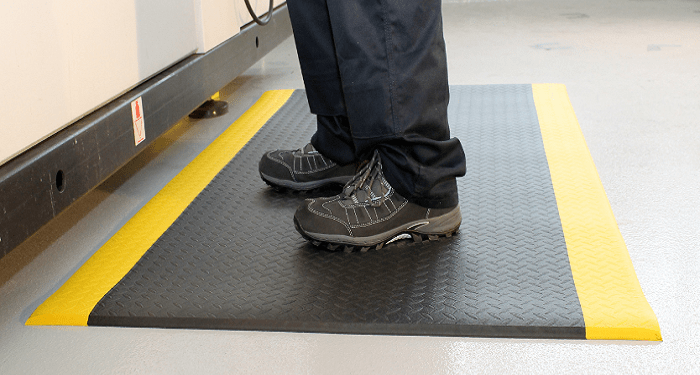Anti-fatigue mats are specially designed mats that are used to reduce fatigue and discomfort for people who need to stand for long periods of time. These mats are commonly used in workplaces where employees are required to stand for extended periods, such as in factories, warehouses, kitchens, and retail settings. Anti-fatigue mats are made from a variety of materials, including rubber, vinyl, wood, and foam, and they are designed to provide cushioning and support to the feet and legs, which can help to reduce the strain and discomfort associated with standing for long periods.
Anti-fatigue mats come in a variety of shapes, sizes, and designs to suit different work environments and preferences. Some mats are designed to be used in specific areas, such as behind a cashier’s counter or in front of a workbench, while others are more versatile and can be used in multiple locations. These mats are an important tool for promoting employee comfort and well-being in the workplace, and they can help to reduce the risk of musculoskeletal disorders and injuries caused by prolonged standing.
Key Takeaways
- Anti-fatigue mats are specially designed mats that provide cushioning and support to reduce fatigue and discomfort from standing for long periods of time.
- These mats work by encouraging subtle movements of the leg and calf muscles, which in turn promotes better circulation and reduces the strain on the body.
- Using anti-fatigue mats can lead to reduced muscle fatigue, improved posture, and decreased risk of slips, trips, and falls in the workplace.
- There are different types of anti-fatigue mats available, including foam, gel, and rubber mats, each with their own unique benefits and features.
- When choosing the right anti-fatigue mat for your workspace, consider factors such as material, thickness, size, and the specific needs of your employees.
How do Anti-Fatigue Mats Work?
Anti-fatigue mats work by providing a cushioned and supportive surface for people to stand on, which helps to reduce the strain and discomfort on their feet, legs, and lower back. When a person stands on a hard surface for an extended period of time, the muscles in their feet and legs can become fatigued and sore, which can lead to discomfort and decreased productivity. Anti-fatigue mats are designed to alleviate this strain by providing a soft and supportive surface that encourages subtle movements of the feet and legs, which can help to improve circulation and reduce fatigue.
The cushioning effect of anti-fatigue mats also helps to reduce the impact on the joints and muscles, which can help to prevent injuries and musculoskeletal disorders. Additionally, the slight movements encouraged by the soft surface of the mat can help to stimulate blood flow and prevent stiffness, which can further reduce the risk of discomfort and fatigue. Overall, anti-fatigue mats work by providing a comfortable and supportive surface for people to stand on, which can help to reduce the physical strain and discomfort associated with prolonged standing.
The Benefits of Using Anti-Fatigue Mats
There are numerous benefits to using anti-fatigue mats in the workplace. One of the primary benefits is the reduction of fatigue and discomfort for employees who are required to stand for long periods of time. By providing a cushioned and supportive surface, anti-fatigue mats can help to alleviate the strain on the feet, legs, and lower back, which can lead to increased comfort and productivity. Additionally, these mats can help to reduce the risk of musculoskeletal disorders and injuries caused by prolonged standing, which can lead to decreased absenteeism and healthcare costs for employers.
Another benefit of using anti-fatigue mats is the improvement of employee morale and well-being. By investing in the comfort and safety of their employees, employers can demonstrate that they value their workforce and are committed to providing a healthy work environment. This can lead to increased job satisfaction and loyalty among employees, which can have a positive impact on retention rates and overall productivity. Additionally, by reducing the physical strain and discomfort associated with standing for long periods, anti-fatigue mats can help to improve employee focus and concentration, which can lead to improved performance and efficiency in the workplace.
Different Types of Anti-Fatigue Mats
There are several different types of anti-fatigue mats available, each with its own unique features and benefits. One common type of anti-fatigue mat is made from rubber, which provides a durable and slip-resistant surface that is suitable for a wide range of work environments. Rubber mats are often used in industrial settings, such as factories and warehouses, where they can provide cushioning and support for employees who are required to stand on hard concrete floors for extended periods.
Another popular type of anti-fatigue mat is made from foam, which offers a soft and comfortable surface that is ideal for areas where employees need to stand for long periods, such as behind a cashier’s counter or in a commercial kitchen. Foam mats are lightweight and easy to move, making them a versatile option for businesses that need to be able to reposition their anti-fatigue mats as needed. Additionally, foam mats are often available in a variety of colors and designs, allowing businesses to choose a mat that complements their branding and decor.
In addition to rubber and foam mats, there are also anti-fatigue mats made from vinyl, wood, and other materials, each with its own unique benefits and features. Some mats are designed with beveled edges to reduce tripping hazards, while others have drainage holes to allow liquids to flow through, making them suitable for wet or oily work environments. With such a wide variety of options available, businesses can easily find an anti-fatigue mat that meets their specific needs and preferences.
Tips for Choosing the Right Anti-Fatigue Mat for Your Workspace
When choosing an anti-fatigue mat for your workspace, there are several factors to consider to ensure that you select the right mat for your needs. One important factor to consider is the type of work environment where the mat will be used. For example, if you need a mat for an industrial setting with heavy machinery or oily surfaces, you may want to choose a mat with drainage holes to allow liquids to flow through. On the other hand, if you need a mat for a retail or office setting, you may prefer a mat with a more stylish design that complements your decor.
Another important factor to consider when choosing an anti-fatigue mat is the size and shape of the mat. It’s important to select a mat that is large enough to provide adequate coverage for employees who need to stand for long periods, but not so large that it becomes difficult to move or clean. Additionally, some work areas may require custom-shaped mats to fit around equipment or furniture, such as a function venue in Bassendean or high foot traffic businesses, so it’s important to consider the layout of your workspace when choosing a mat.
It’s also important to consider the durability and maintenance requirements of the mat. For example, if you need a mat for a high-traffic area or an industrial setting, you may want to choose a durable rubber mat that is easy to clean and resistant to wear and tear. On the other hand, if you need a mat for a more low-traffic area or a retail setting, you may be able to choose a softer foam or vinyl mat that requires less maintenance.
How to Use Anti-Fatigue Mats to Boost Productivity
In addition to providing comfort and safety for employees who need to stand for long periods of time, anti-fatigue mats can also be used as a tool to boost productivity in the workplace. One way to use anti-fatigue mats to improve productivity is by strategically placing them in areas where employees need to stand for extended periods. For example, placing anti-fatigue mats behind cashier counters or in front of workstations can help to reduce fatigue and discomfort for employees who spend long hours on their feet, which can lead to increased focus and efficiency.
Another way to use anti-fatigue mats to boost productivity is by encouraging employees to take short breaks throughout their shift to stretch and move around. By providing comfortable anti-fatigue mats in designated break areas, employers can create a space where employees can relax and rejuvenate during their breaks, which can help to prevent fatigue and improve overall well-being. Additionally, encouraging employees to take short breaks can help to prevent stiffness and promote circulation, which can lead to increased energy levels and productivity when they return to their workstations.
Employers can also use anti-fatigue mats as part of a comprehensive ergonomic program designed to promote employee health and well-being. By providing comfortable and supportive surfaces for employees who need to stand for long periods, employers can demonstrate their commitment to creating a safe and healthy work environment. This can lead to increased job satisfaction and loyalty among employees, which can have a positive impact on productivity and overall performance in the workplace.
Additional Ways to Improve Productivity in the Workplace
In addition to using anti-fatigue mats as a tool to improve productivity in the workplace, there are several other strategies that employers can implement to create a more productive work environment. One effective strategy is to provide ergonomic furniture and equipment that is designed to promote comfort and reduce strain on the body. For example, providing adjustable chairs and desks can help employees maintain proper posture and reduce the risk of discomfort and fatigue.
Another way to improve productivity in the workplace is by promoting regular physical activity among employees. Encouraging employees to take short breaks throughout their shift to stretch or walk around can help prevent stiffness and fatigue, which can lead to increased energy levels and productivity. Additionally, employers can consider offering wellness programs or incentives for employees who participate in physical activity during their breaks or outside of work hours.
Creating a positive work culture that values employee well-being and work-life balance is another important way to improve productivity in the workplace. Employers can demonstrate their commitment to employee health by offering flexible work schedules or remote work options that allow employees to better manage their personal responsibilities while maintaining their productivity at work. Additionally, providing opportunities for professional development and career advancement can help employees feel valued and motivated in their roles.
In conclusion, anti-fatigue mats are an important tool for promoting employee comfort and well-being in the workplace. These mats provide cushioning and support for people who need to stand for long periods of time, helping to reduce fatigue and discomfort while also reducing the risk of musculoskeletal disorders and injuries caused by prolonged standing. By choosing the right type of anti-fatigue mat for your workspace and strategically placing them in areas where employees need them most, employers can use these mats as part of a comprehensive strategy to boost productivity in the workplace. Combined with other strategies such as promoting regular physical activity among employees and creating a positive work culture that values employee well-being, anti-fatigue mats can contribute significantly towards creating a healthier, more productive work environment.











